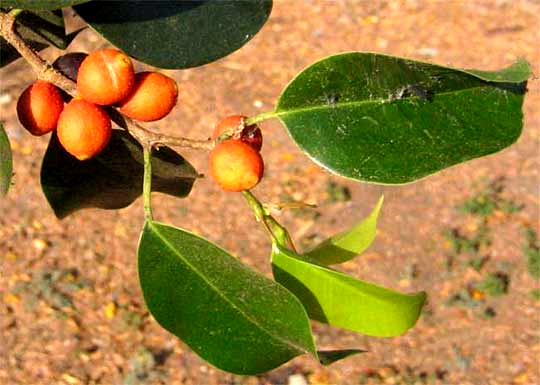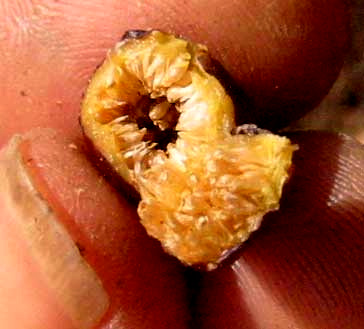Excerpts from Jim Conrad's
Naturalist Newsletter
from the March 10, 2008 Newsletter written in the community of 28 de Junio, in the Central Valley 8 kms west of Pujiltic, elev. ~700m (2300ft), ~N16.331°, ~W92.472°; southeastern Chiapas state, MÉXICO
CACOPHONOUS FIG-TREE
Back in the Yucatan I introduced you to strangler figs. We saw how they start out as little bushes growing epiphytically on a host-tree's limbs. They send viny roots earthward, the roots grow and merge with one another, and eventually the little bush becomes a tree that out-competes and overtops, or strangles, the host tree, eventually replacing it. The resulting fig tree looks like any normal tree developing the usual way. A picture showing a Yucatec strangler after it's replaced its host but before its many roots have merged into a normal trunk is at www.backyardnature.net/yucatan/stranglr.htm.
Strangler figs are common here and right now some are producing prodigious amounts of small, spherical figs. Remember that our American figs produce much smaller fruits than the does the Common Fig of commerce, which is a native of the Mediterranean Region, plus they produce different-shaped leaves. You can see a fig-bearing, leafy branch from one of our big strangler figs, the figs smaller than a fingernail, below:

During most of the fig-fruit's development it's hard and green but now many of them are orange and semi-soft. When they're completely mature they turn dark brown and really soft. The brown ones don't last long, though, because birds eat them. Unfortunately, to human tastes they're so bland and pithy that they're not worth fooling with them.
Still, those big stranglers are bird-paradises. Not only do they offer an all-day banquet to all comers but also, in stark contrast to most other trees here, the figs' leaves are as green as at the peak of the rainy season, and they're produced so close together that they form dense shadows inside the trees, which birds crave during the midday heat and glare.
Many bird-types visit the stranglers but at mid-day the most common species in the big one next to the church are Great-tailed Grackles and Social Flycatchers. Both of these species are famous for their ceaseless, often shrill calling, so at mid-day when most of the world here is withdrawing into heat- induced torpor the big strangler is like a circus on free-to-kids day. Beneath the tree there's of a continual shower of fig fragments and bird doo.
Remember that fig fruits, including the big ones bought at the market, are very unusual anatomically. You know how a composite flower such as a sunflower is actually composed of many tiny flowers crammed together on a flattish disk. Fig fruits start out in a similar way, except that many tiny pistils are stacked next to one another on the inner surface of a spherical object. Think of the edges of a sunflower's flattish disk curving upward and then coming together, leaving the sunflower's disk flowers inside the structure all pointing toward the sphere's center.
Below, you can see a split-open fig from our church tree, with each tiny, grainy thing being an ovary with its pointy style directed toward the fig's open center.

You might wonder how the pistils preceding the maturation of these strange fruits, which technically are called syconiums, ever get pollinated. The syconium has a small opening opposite its pedicel attachment, and a certain species of tiny wasp enters the fruit where it walks around inside it distributing pollen from other syconiums and gathering new pollen.